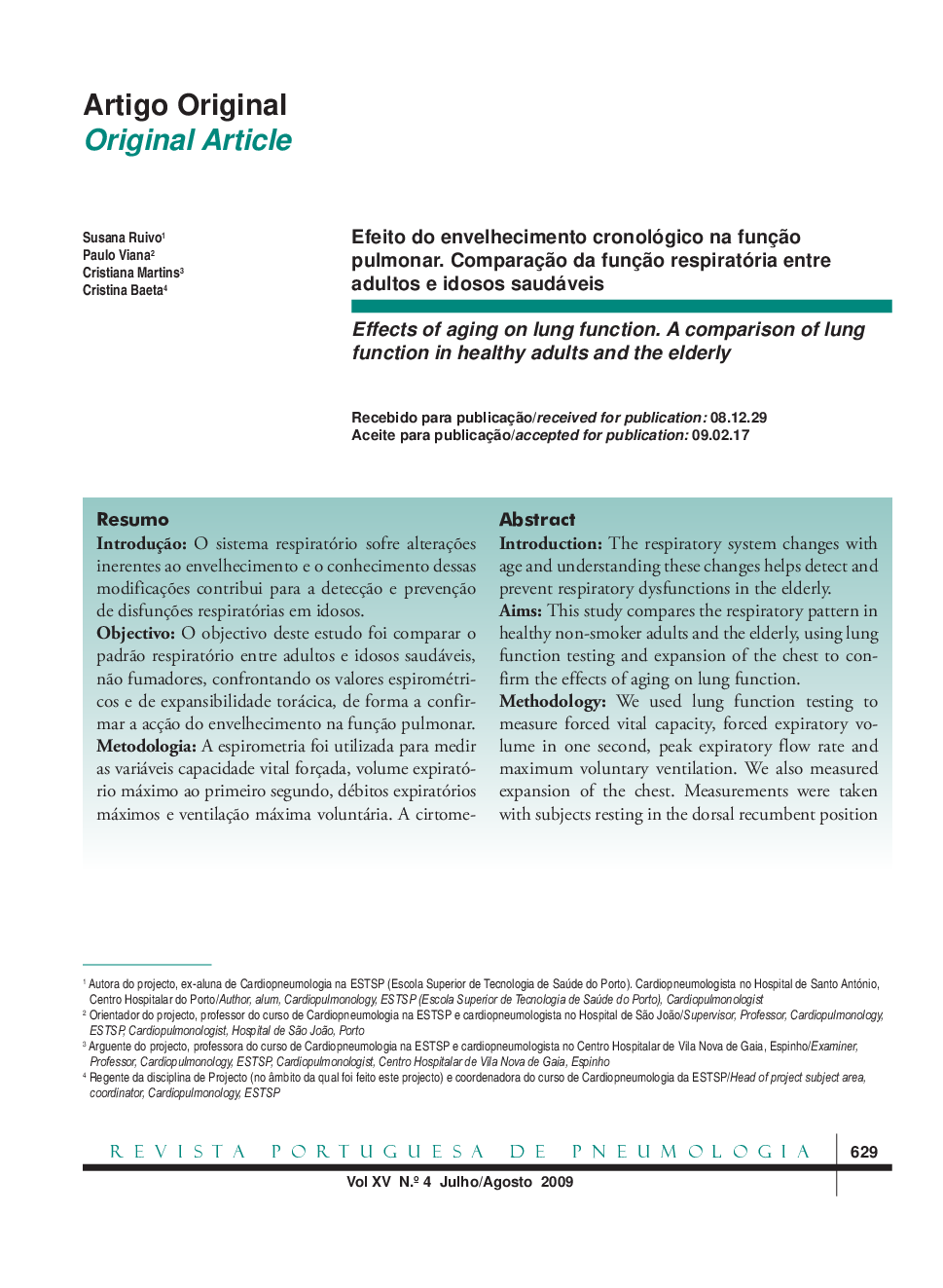| Article ID | Journal | Published Year | Pages | File Type |
|---|---|---|---|---|
| 4215280 | Revista Portuguesa de Pneumologia (English Edition) | 2009 | 25 Pages |
IntroductionThe respiratory system changes with age and understanding these changes helps detect and prevent respiratory dysfunctions in the elderly.AimsThis study compares the respiratory pattern in healthy non-smoker adults and the elderly, using lung function testing and expansion of the chest to confirm the effects of aging on lung function.MethodologyWe used lung function testing to measure forced vital capacity, forced expiratory volume in one second, peak expiratory flow rate and maximum voluntary ventilation. We also measured expansion of the chest. Measurements were taken with subjects resting in the dorsal recumbent position with upper body elevated to 45°. Statistical analysis consisted of the Student T test for independent samples, the non-parametric Mann-Whitney test with a p < 0.05 level, and linear regression analysis, also with a p < 0.05 level, to assess correlation between variables studied and age.Our population consisted of 35 elderly subjects and 35 adults. 15 of the elderly subjects were male (43%) and 20 female (57%). 16 of the adult group were male (46%) and 19 female (54%). The sample was mapped in terms of age, weight, height, abdominal girth and clinical data, to exclude factors which could distort the results.ResultsThe difference between the two study groups attained statistical significance for all parameters measured. The linear relationship was also significant between age and all parameters and a negative and significant correlation was seen. Expansion of the chest in females was the parameter most inversely correlated with age (60.37%). The lung function testing variable with the greatest difference between the groups was peak expiratory flow rate (35.77% in females and 36.17% in males).ConclusionsOur results show differences in the respiratory patterns of healthy adults and the elderly, suggesting that age impacts on lung function. Both male and female elderly subjects had lower lung function testing scores than the adult subjects, with this difference more marked in females.
ResumoIntroduçãoO sistema respiratório sofre alterações inerentes ao envelhecimento e o conhecimento dessas modificações contribui para a detecção e prevenção de disfunções respiratórias em idosos.ObjectivoO objectivo deste estudo foi comparar o padrão respiratório entre adultos e idosos saudáveis, não fumadores, confrontando os valores espirométricos e de expansibilidade torácica, de forma a confirmar a acção do envelhecimento na função pulmonar.MetodologiaA espirometria foi utilizada para medir as variáveis capacidade vital forçada, volume expiratório máximo ao primeiro segundo, débitos expiratórios máximos e ventilação máxima voluntária. A cirtometria foi utilizada para medir a expansibilidade torácica. As medidas foram registadas em repouso, com os sujeitos posicionados em decúbito dorsal a 45° de inclinação do tronco. A análise estatística aplicada foi o teste t de Student para amostras independentes e o teste não paramétrico Mann-Whitney considerando significativo p < 0,05. Com o mesmo nível de significância, foi aplicada a análise de regressão linear e determinada a correlação entre as variáveis em estudo e a idade. Estudaram-se 35 idosos e 35 jovens/adultos. Dos primeiros, 15 eram homens (43%) e 20 mulheres (57%), constando 16 homens (46%) e 19 mulheres (54%) no grupo dos jovens adultos. Foram recolhidas características da amostra, como idade, peso, altura, perímetro abdominal, bem como dados clínicos, para excluir factores de enviesamento dos resultados.ResultadosPara os homens e mulheres estudados, a diferença entre os dois grupos foi estatisticamente significativa, para todas as medidas avaliadas. A relação linear foi, também, significativa entre a idade e todos os parâmetros e observou-se correlação negativa e significativa. A expansibilidade torácica no género feminino revelou ser a medida mais inversamente correlacionada com a idade (60,37%). A variável espirométrica com maior diferença entre os grupos foi o débito expiratório máximo instantâneo (35,77% no género feminino e 36,17% no género masculino).ConclusõesOs resultados mostraram que houve diferenças do padrão respiratório entre jovens adultos e idosos saudáveis, sugerindo que a função pulmonar é influenciada pelo envelhecimento cronológico. Em ambos os géneros, os indivíduos idosos apresentaram valores espirométricos mais baixos do que os indivíduos adultos, sendo esta diferença maior no género feminino.
